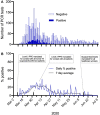SARS-CoV-2 Testing of 11,884 Healthcare Workers at an Acute NHS Hospital Trust in England: A Retrospective Analysis
- PMID: 33777979
- PMCID: PMC7994756
- DOI: 10.3389/fmed.2021.636160
SARS-CoV-2 Testing of 11,884 Healthcare Workers at an Acute NHS Hospital Trust in England: A Retrospective Analysis
Abstract
Healthcare workers (HCWs) are known to be at increased risk of infection with SARS-CoV-2, although whether these risks are equal across all roles is uncertain. Here we report a retrospective analysis of a large real-world dataset obtained from 10 March to 6 July 2020 in an NHS Foundation Trust in England with 17,126 employees. 3,338 HCWs underwent symptomatic PCR testing (14.4% positive, 2.8% of all staff) and 11,103 HCWs underwent serological testing for SARS-CoV-2 IgG (8.4% positive, 5.5% of all staff). Seropositivity was lower than other hospital settings in England but higher than community estimates. Increased test positivity rates were observed in HCWs from BAME backgrounds and residents in areas of higher social deprivation. A multiple logistic regression model adjusting for ethnicity and social deprivation confirmed statistically significant increases in the odds of testing positive in certain occupational groups, most notably domestic services staff, nurses, and health-care assistants. PCR testing of symptomatic HCWs appeared to underestimate overall infection levels, probably due to asymptomatic seroconversion. Clinical outcomes were reassuring, with only a small minority of HCWs with COVID-19 requiring hospitalization (2.3%) or ICU management (0.7%) and with no deaths. Despite a relatively low level of HCW infection compared to other UK cohorts, there were nevertheless important differences in test positivity rates between occupational groups, robust to adjustment for demographic factors such as ethnic background and social deprivation. Quantitative and qualitative studies are needed to better understand the factors contributing to this risk. Robust informatics solutions for HCW exposure data are essential to inform occupational monitoring.
Keywords: COVID-19; Healthcare workers (HCWs); SARS-CoV-2; nosocomial infection; occupational risk analysis and management.
Copyright © 2021 Hanrath, Schim van der Loeff, Lendrem, Baker, Price, McDowall, McDowall, Cook, Towns, Schwab, Evans, Dixon, Collins, Burton-Fanning, Saunders, Harwood, Samuel, Schmid, Pareja-Cebrian, Hunter, Murphy, Taha, Payne and Duncan.
Conflict of interest statement
The authors declare that the research was conducted in the absence of any commercial or financial relationships that could be construed as a potential conflict of interest.
Figures




References
Grants and funding
LinkOut - more resources
Full Text Sources
Other Literature Sources
Miscellaneous

